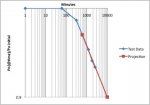I was about to write a long post explaining what should and should not be done and why, but i have a whole lot of work to do and two weeks worth of emails to answer, so i'll be short.
I never intended to stop the first experiment for anything other than re-plotting, nor change it's conditions... In this hobby, the "useful life" of a diode ends when a diode pops... And we usually don't change currents after a laser is built.
The experiments are meant to give builders an approximate idea of what to expect. And that's why the experiments should relate to what we usually build.
Also, the 100h mark was just one of my suggestions for a standard of "reliability". In the meanwhile i realized even half as much is plenty for a hobby pointer.
But i don't want to stop the test because i want to know:
- How long the diode will survive this current
- How fast it will degrade with time
- How much it will degrade before dying
All these bits of info will be of EXTREME importance during the following tests, including that of the 12x!
And we can't get to them, unless i leave the first diode as it is, and test it often enough not to miss any big changes in it's behavior.
Since degradation is slowing down, i won't even re-plot it until the 60h mark, unless of course i notice a kink developing, which is why i still check it's beam profile twice a day.
I was mostly wondering what current to test the second diode at. And when i thought about starting the second experiment sooner, it did not imply stopping the first (the torture chamber can handle multiple diodes at once, if i add sensors and counters).
When it comes to the second diode, there are several things that interest me.
Obviously i want to know how long it can live at higher currents/powers.
But believe it or not, i am just as interested in how long it would survive at the same current (i'll explain why)!
Problem is, i can't test both. And testing higher currents/powers is of interest to many of us. That's why i was thinking of a middle ground. A current, which would give answers about higher powers, but not make the second experiment completelly unrelateable to the first one...
And the reason i can't test both - as Dave already explained - is, that if the diode is tortured at one current first, and then the current is raised, the data from the second or third current does not tell us how long the diode would have lived there! It only tells us how long it lived there AFTER having been tortured at lower currents first.
Unfortunatelly every diode will degrade at a different rate and to a different level before dying, making it impossible to extrapolate data from a single step. In fact, we've seen that degradation slows down with.... ....degradation, making things even more complicated!
Unfortunatelly, my experience with torturing and killing diodes is mostly limited to PHRs, a small number of 4x's and some GGWs...
PHRs would usually degrade by around 3% before dying, when overdriven hard.. The 4x i cycled seemed to degrade a lot, but it fell into a kink, making the numbers meaningless.. My first GGW degraded almost 5%, but then i set the current higher, after which it died rapidly, and now i don't know how far it would have degraded if i left everything the same...
With GGWs, i can rely on the efficiency being a good sign of health, there higher efficiency diodes will outlive lower efficiency ones, when set to same currents. With PHRs (and 4x's) kinks made things a little more complicated.
But since those were all reject sleds, and evidence exists some of them were even prototype sleds, i can't say for sure the same will hold true with 8x's from drives...
It's unlikelly, but in theory at least, a higher efficiency diode could kill itself faster, due to the higher optical flux it produces at the same current.
While i'm pretty sure efficiency is a sign of diode health, it's not the only factor involved...
I have killed many diodes and quite a few in stupid ways, but none of them cost almost $200 a pop...
We have a very limited number of diodes available for sacrifice to the lazor gawdz, and that's why we need to squeeze them for as much info as possible.
But for the same reason, we also have to squeeze very carefully.
P.S. And yes, this was the short version. :angel:





